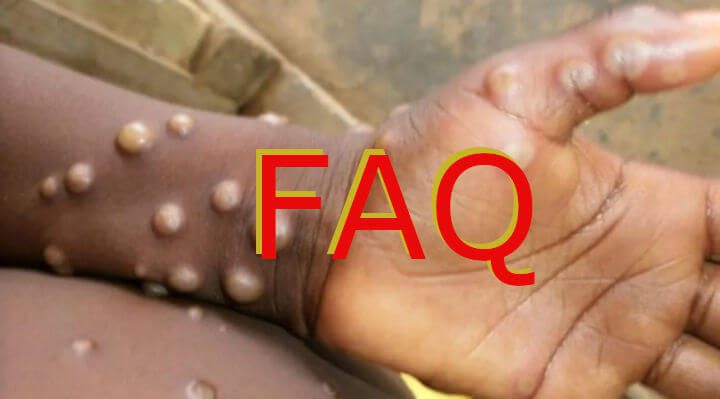You can read the ‘What is Monkeypox? A General Description‘ article for the major concerns such as what the virus is, what it looks like, the symptoms, the origins, and all.
It is important to understand that Monkeypox wasn’t considered a serious threat until now and so lots of the answers to the questions are hypothetical in nature. The World Health Organization has paid attention to the recent cases and has allocated resources for further research work.
The reason it was named ‘Monkeypox’ is because it was first discovered in monkeys. In 1958, a batch of monkeys intended for tests at a pharmaceutical laboratory in Denmark displayed this disease. They were of African origin.
Although later they found out that the real hosts of the virus were several African rodents, the name ‘Monkeypox’ stuck.
Although it is named ‘Monkeypox’, monkeys are not the natural hosts of this virus. It resides in the rodent family. The natural hosts are rodents in the rainforest areas of the African Continent.
As far as we know, African rope squirrels, tree squirrels, Gambian pouched rats, and dormice are the natural hosts of this virus. Further research is required to identify the specifics, especially to find out in what body parts of these rodents does the virus reside.
This situation is called Zoonosis, which means that this virus has suddenly developed the ability to jump onto humans and can create a habitat in human cells. Monkeys were the first victims of the interspecies jump at a pharmaceutical laboratory in Denmark. Hence, we call it ‘Monkeypox‘.
This is a bit strange to answer. This recent outbreak is now being reported from almost all over the world. West and Central Africa, Asia, Europe, North and South America, Mediterranean regions, and Australia have reported cases of Monkeypox. The latest reported cases are shown on the map below:
[pic]
Several of the patients have a recent travel history to Nigeria and the Democratic Republic of Congo. These are known to be the origin countries of this virus. WHO has not yet determined the extent of the spread and should travel bans be recommended.
For now, there is nothing much to worry about and people can travel anywhere. Although many skeptics are arguing that it was the same thing experts said at the beginning of the Coronavirus outbreak. However, there is a significant difference.
Coronavirus made its Zoonosis for the very first time. We didn’t know anything about it. People had no immunity against it, and we had to way to treat it or had developed a vaccine for it.
On the other hand, this is not the first time Monkeypox infected humans. There are several small outbreak records, which we will discuss in the ‘Monkeypox Outbreak History’ article. We have treatments and vaccines for it.
We also know how it spreads and how to protect ourselves against it.
The elderly and very young babies take priority in this matter due to their weak immune systems. However, it is important to remember that the probable cause of this outbreak is the withdrawal of WHO from vaccinating Central African countries against Smallpox.
Yes, an antiviral agent called ‘Tecovirimat‘, which was also used for Smallpox works for Monkeypox as well. However, the administration of Tecovirimat should be done in a clinical setting and supervised by a medical professional.
To reduce the fever, headaches, and other associate discomforts, some non-steroidal analgesics such as aspirin or acetaminophen can help. Antihistamines can also provide comfort, especially to help patients fall asleep.
Here are a few things you should do right away:
- Inform the local healthcare center and report it.
- If they have a facility to treat Monkeypox, go to it.
- If you would rather take care of it at home, make sure you isolate yourself so that the other members of the family don’t catch it.
- Avoid any physical or sexual contact.
- Isolate your clothes and utensils like spoons, plates, and cups.
- If you are not feverish, take a shower or a bath in lukewarm water. Epsom salt or some baking soda in the bath water may also help with skin lesions.
- If skin lesions start to show, do not scratch.
- Keep the lesions clean as much as possible and treat the skin rashes and lesions with antiseptic cream or lotion.
- You may also use some anti-itching creams. Near the end, the lesions start to itch.
- Cover yourself with a blanket while sleeping. It keeps the body warm and helps the immune system.
- Keep hydrated. Drink plenty of water and chicken soup as much and as often as you can.
- Do not work, and do not go outside.
- If you are in an isolated room, you may do some stretching exercises if your body permits. It increases blood flow and hastens recovery.
- If you are a breastfeeding mother, you can not breastfeed at this time.
Stay in touch with your doctor or the local healthcare center and report if the symptoms get too uncomfortable.
- Keep clean at all times.
- Wash your face and hands when you return home from outside.
- Sanitize your hands after using a public facility (restrooms, restaurants, ETC)
- Wear a mask while outside.
- Avoid close proximity to someone, you know, has been diagnosed with Monkeypox.
- Follow the general health regimen (Eat healthy, drink much water, and exercise).
- Sleep for at least 6-7 hours a day.
- Refrain from sexual conduct (Kiss and intercourse) with someone you have just met.
- If you can help it, do not make an international trip at this time.
Smallpox is a lot more dangerous. Although Monkeypox comes from the same ‘Orthopoxvirus‘ family, it is not that contagious and not that fatal. At its prime, Smallpox had a kill rate of over 30%. Whereas, Money pox has less than 1%.
However, the Congo strain of Monkeypox had seen a fatality rate of 13%.
As always, people with weaker immune systems are more vulnerable than others when it comes to viral infections. To that end, the elderly over 70 years and above should be more careful.
Children under 10 years of age are also vulnerable as they do not have a fully developed immune system yet. Average adults do not have much to worry about.
However, people with immune-compromising diseases like AIDS must take care at these times. It is not yet confirmed, but naturally, they are the most at risk from an infection like this.
Awareness is the key. Keep yourself and your family members informed at all times. Wash, clean, and keep dry the things all the family members use. Practice better health routines.
If you have children who go to school, provide them with masks and hand sanitizers and inform them of the importance of using them. Regular bathing and washing should be encouraged.
It is already an outbreak- just not a major one yet. Again, we shall discuss more on the ‘History of Monkeypox Outbreaks’ in a different article. The reason Monkeypox did not gain attention is that it was contained only in one region.
A major scientific feasibility study under the direction of WHO is currently underway to assess the possibility of a major outbreak.
Additionally, it would not help whether the people involved use protection or not.
There is no research or study to confirm it. Sars-COV2 (Coronavirus) and MPXV (Monkeypox Virus) are not from the same family. However, it all comes down to the immune system.
While recovering COVID patients have a weaker one, fully recovered and vaccinated COVID patients should have a stronger immune system. Nevertheless, we can not jump to any conclusion here. More study is necessary.
It is a concern. A Monkeypox infection during pregnancy may risk both the mother and the baby. If that’s you, you must contact the nearest healthcare center or your personal physician immediately.
As for the fetus, it mirrors the mother when it comes to the immune system. If the mother’s immune system is strong, the baby should be protected as well.
However, in only one case in Congo, a mother reported a miscarriage. You can read about it in our ‘The History of Monkeypox Outbreak‘ article.
Not at all. Body fluids are an ideal way of transmission and a sick mother should not breastfeed the child until fully healed. There are formulas that can substitute breastmilk for the time being.
We can’t say for sure yet, but the possibility is very very low. Smallpox and Monkeypox are from the same family ‘Orthopoxvirus’ and Smallpox vaccines work well against Monkeypox as well.
However, Smallpox was eradicated and the vaccination program stopped. If you had had it, that must be at least 20 years ago. Therefore, we can’t exactly say that it is still effective at this moment.
That’s why interested recipients are encouraged to report to the nearest healthcare center for an antigen test. You may even help others if you have developed permanent antibodies for Smallpox. It is the same antibody that defends against Monkeypox.
A further and deeper study is required for this but in general, yes. Cats are not very likely but dogs are from the rodent family. Monkeypox is a rodent virus.
We are not sure how a domestic dog’s body would behave. They may become hosts and not get sick. Yet, there is a big probability that pets can transmit and spread the disease.
The 2003 outbreak in the United States suggests that the prairie dogs host this virus. We’ll discuss this in detail in our ‘The History of Monkeypox Outbreaks‘ article.
There is not enough study on this subject either. As mentioned earlier, dogs may be vulnerable and may catch it from humans. More research is required.
Again, more study is required. You may already have developed antibodies for that. However, since the infection is not that common and many people have not been exposed to it for a long time, the antibodies may have been let go.
One interesting thing about our body is that it gets rid of things it doesn’t need.
Most definitely yes. Do not give blood if you are feeling sick. Do not receive blood before verifying that the person who donated the blood is fully healthy.
Share this:
- Click to share on X (Opens in new window) X
- Click to share on Facebook (Opens in new window) Facebook
- Click to share on LinkedIn (Opens in new window) LinkedIn
- Click to share on Pinterest (Opens in new window) Pinterest
- Click to share on WhatsApp (Opens in new window) WhatsApp
- Click to share on Tumblr (Opens in new window) Tumblr
- Click to print (Opens in new window) Print


